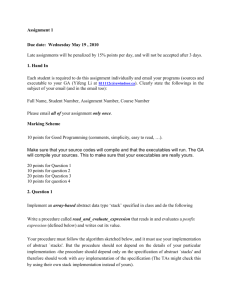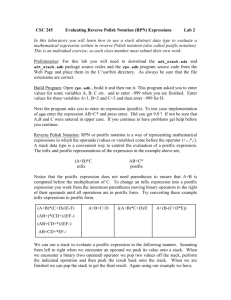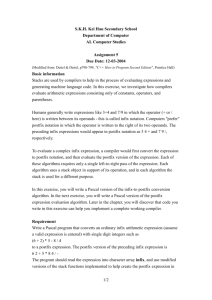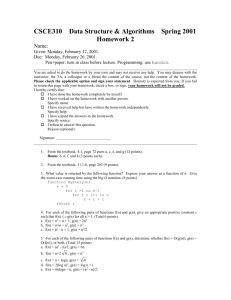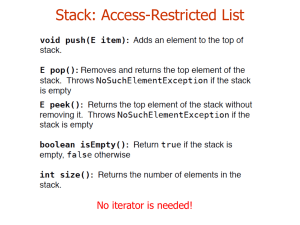Lecture 5
advertisement
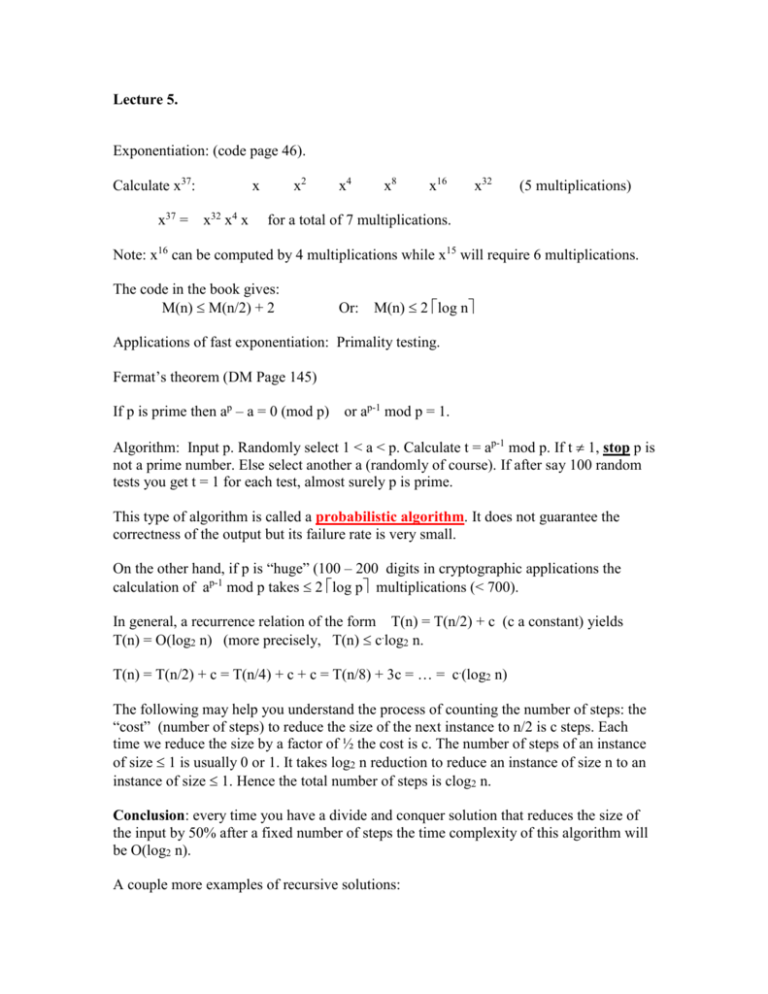
Lecture 5.
Exponentiation: (code page 46).
Calculate x37:
x37 =
x2
x
x32 x4 x
x4
x8
x16
x32
(5 multiplications)
for a total of 7 multiplications.
Note: x16 can be computed by 4 multiplications while x15 will require 6 multiplications.
The code in the book gives:
M(n) M(n/2) + 2
Or:
M(n) 2 log n
Applications of fast exponentiation: Primality testing.
Fermat’s theorem (DM Page 145)
If p is prime then ap – a = 0 (mod p) or ap-1 mod p = 1.
Algorithm: Input p. Randomly select 1 < a < p. Calculate t = ap-1 mod p. If t 1, stop p is
not a prime number. Else select another a (randomly of course). If after say 100 random
tests you get t = 1 for each test, almost surely p is prime.
This type of algorithm is called a probabilistic algorithm. It does not guarantee the
correctness of the output but its failure rate is very small.
On the other hand, if p is “huge” (100 – 200 digits in cryptographic applications the
calculation of ap-1 mod p takes 2 log p multiplications (< 700).
In general, a recurrence relation of the form T(n) = T(n/2) + c (c a constant) yields
T(n) = O(log2 n) (more precisely, T(n) c.log2 n.
T(n) = T(n/2) + c = T(n/4) + c + c = T(n/8) + 3c = … = c.(log2 n)
The following may help you understand the process of counting the number of steps: the
“cost” (number of steps) to reduce the size of the next instance to n/2 is c steps. Each
time we reduce the size by a factor of ½ the cost is c. The number of steps of an instance
of size 1 is usually 0 or 1. It takes log2 n reduction to reduce an instance of size n to an
instance of size 1. Hence the total number of steps is clog2 n.
Conclusion: every time you have a divide and conquer solution that reduces the size of
the input by 50% after a fixed number of steps the time complexity of this algorithm will
be O(log2 n).
A couple more examples of recursive solutions:
Example 1.
Recall “Hotel Infinity” f: NxN N.
This function can be calculated by a very simple recursive computation. Here is a
Mathematica implementation:
In[3]:= hotel[k_,n_]:=If[k+n==2,1,k + hotel[n+k-2,1]]
In[4]:= hotel[1,1]
Out[4]= 1
In[5]:= hotel[2,2]
Out[5]= 5
In[6]:= hotel[56,4]
Out[6]= 1767
Example 2
BubbleSort(A, n)
//Buuble sort the array A with n entries, n used for the recursive call.
if (n > 0) {
for(j = 1; j < n; j++)
comp_exc(A[j-1], A[j]);
BubbleSort(A, n –1);
Analysis: B(n) = B(n-1) + (n-1)
By induction: B(n) = n(n-1)/2.
B(1) = 0 = 1(1-1)/2
B(n) = n(n-1)/2.
B(n+1) = (n+1)n/2
B(n+1) = B(n) + n = n(n-1)/2 + n = (n2 – n + 2n)/2 = (n+1)n/2
B(n) = O(n2).
Data structures and Algorithms:
Polynomials: Horner’s method (page 51 #2.14)
Let p(x) = 4x4 + 8x3 + x + 2
(7 multiplications, 3 additions)
p(x) = ((4x + 8)x2 + 1 )x + 2
(4 multiplications).
In general: p(x) = anxn + an-1xn-1 + … + a1x + a0 can be evaluated at a specific x by only n
multiplications:
p(x) = ((…(anx + an-1)x + an-2)x + …a2)x + a1)x + a0
Representation of polynomials
Array: 4x4 + 8x3 + x + 2 [2, 1, 0, 8, 4]
Analysis of space time operations:
Space: O(n)
Add: O(n)
Multiply O(n2)
“Disaster” for sparse polynomials. 4x40098 + 8x3765 + x56 + 2
A better representation:
(4, 40098)
40098
(8, 3765)
40098
(1, 56)
40098
(2, 0)
40098
A polynomial with k terms will take O(k) space regardless of its degree. Additions and
multiplications will be done in O(k+m) and O(km) respectively for two polynomials of
degrees k and m.
Application of linked lists:
Radix Sort.
Definition: A sort is called STABLE if ai = aj
and i < j then in the final sort ai will appear
before aj.
RadixSort(Data);
Sort the following array:
928 205 714 693 332 13 227 128
944 773 374 569 207 576 725 548
761 449 726 748 585 295 194 718
//Group by last digit:
761 332 693 13 773 714 944 374
194 205 725 585 295 576 726 227
207 928 128 548 748 718 569 449
Each color is a separate linked list. We need 10
lists for this process.
//Group by next digit Broken into linked lists:
205 207
13 714 718
725 726 227
928 128
332
944 548 748 449
761 569
773 374 576
585
693 194 295
Put back in the array:
205 207 13 714 718 725 726 227
928 128 332 944 548 748 449 761
569 773 374 576 585 693 194 295
//Group by next digit
13 128 194 205 207 227 295 332
374 449 548 569 576 585 693 714
718 725 726 748 761 773 928 944
3 passes required. Each pass takes O(n). If the
numbers are 12 digits long, 12 passes will be
required. Altogether, if the size of the input is
bounded by k we’ll execute kn = O(n) data
moves.
RadixSort is a stable sort.
Recall: abstract data types: extract the k-th digit of an integer.
Sparse tables representations: (Page 68)
40,000 students, 2,500 classes. Need class lists, need personal records.
40,000 x 2,500 array. Will “occupy” 100,000,000 cells. Most students take only 4 classes
so there will be about 10,000 non-empty cells. What a waste!!!
Alternative: Multilists. (Figure 3.25 page 68)
Stacks: Push, Pop, IsEmpty
Applications sample:
1. “reverse a list”
2. “reverse” an integer; 2980078600
68700892
3. Balancing parenthesis {a + [b*( a – [c*(a-b)+e]*{a – b*(c – p)}] + 5)*7}*(c – d)
Properly balanced???
Algorithm: process the expression.
Discard everything but parenthesis.
Push a left-handed parenthesis on the stack.
When you encounter a right-handed parenthesis pop the stack and check
whether they match. If not STOP.
If stack is empty when finished processing the expression is syntactically
correct.
4. Evaluate Postfix expressions. 6 5 2 3 + 8 * + 3 + * (pages 82 – 83)
Algorithm:
while more token do {
if(token is numeric) push on stack;
if(token is = op) a = pop(); b = pop(); c = a op b; push(c);
}
return pop()
6 5 2 3 (3 is at the top of the stack) reading +
6 5 5 8 (reading *)
6 5 40 (reading +)
6 45 3 (reading +)
6 48 (reading *)
288
return 228
5. Infix Postfix. (page 84)
Algorithm: Assume infix expression is stored in a string called Infix
a. Read Infix from left to right
b. If current token is numeric append to Postfix
c. If current token read from Infix is ‘(‘ push on stack
d. If current token read from Infix is an operator pop operators (if any) from
the stack as long as they have equal or higher precedence than current
operator and append to Postfix. Push current operator on the stack.
e. If current token read from Infix is ‘)’ pop operators from the stack and
append to Postfix until a ‘(‘ is encountered. Pop ‘(‘ and discard.
f. Pop remaining operators and append to Postfix.
Example: (12 + 5)*(17 – 3) + 67/5 – 2
Stack
Postfix:
(
+ ( (push + rule d.)
Empty (read ‘)’, rule e)
*
( *
( *
(read 17, rule b)
– ( *
– ( *
*
+ (read +, rule d * higher precedence)
+
/ +
/ +
– +
– +
Empty
12
12 5
12 5 +
12 5 + 17
12
12
12
12
12
12
12
12
12
5
5
5
5
5
5
5
5
5
+
+
+
+
+
+
+
+
+
17
17
17
17
17
17
17
17
17
3
3
3
3
3
3
3
3
3
–
–
–
–
–
–
–
–
*
*
*
*
*
*
*
67
67
67
67
67
67
5
5 /
5 / 2
5 / 2 – +




